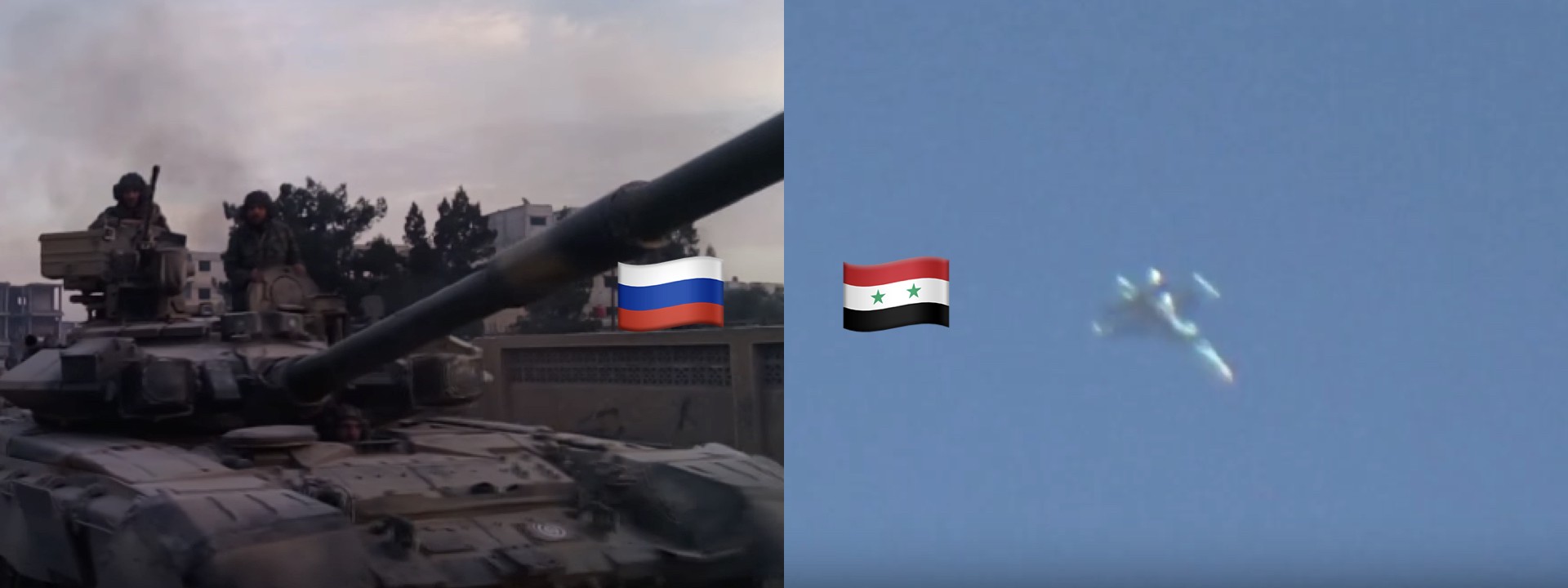#PutinAtWar: Further Signs of Russia’s Involvement in Eastern Ghouta
Continuous monitoring of signs of Russia’s involvement in Eastern Ghouta atrocities
#PutinAtWar: Further Signs of Russia’s Involvement in Eastern Ghouta

Continuous monitoring of signs of Russia’s involvement in Eastern Ghouta atrocities

The attack on Eastern Ghouta continues. According to the Syrian Observatory for Human Rights, during the last 33 days, brutal attacks by the Syrian Arab Army and the Russian military took the lives of at least 1544 Syrian civilians.
On March 13, TASS announced that the Russian Center for Reconciliation of Opposing Sides in Syria has delivered two tons of food to refugees from Eastern Ghouta, but failed to mention any Russian military intervention. According to TASS, the Russian Center for Reconciliation of Opposing Sides in Syria offered the rebel militants a safe passage to leave Eastern Ghouta, which reportedly was refused. The Kremlin made further public statements after the February 21 denial of intervention. @DFRLab continues to monitor Russia’s involvement in the offensive on Eastern Ghouta.
Bombings
Just as in our last monitoring report, most of the videos of attacks in Eastern Ghouta that surfaced did not show clear signs of the responsible party. On March 9, a video was published on YouTube claiming an aerial attack on Irbin (Arbin) in Eastern Ghouta. The video was posted at 15:09 (UTC) and according to reverse image search was not posted before.
The video had enough geolocation data to verify that the location was, in fact, the town of Irbin, Syria.

The location of the video appeared to be in the southwestern part of Irbin, Eastern Ghouta. Two minarets visible in the background and a water tower served as indicators in confirming the location.

Just as during the attacks on February 21, a Russian Sukhoi Su-34 (NATO reporting name: Fullback) was used. There is no doubt that the Su-34 captured in the video is Russian, since the Syrian Air Force does not possess these aircraft. Also, Russia reportedly deployed Su-34 to Syria as early as September 2015, and the aircraft were also captured on satellite imagery in Khmeimim Airbase.

Russian T-90As
Another video capturing Russian signs of involvement surfaced on March 11. Ruptly published a video on YouTube at 11:52 (UTC), claiming to depict the Syrian Arab Army in the town of Mesraba (Mesaraba), Eastern Ghouta. What caught our attention were the three Russian made T-90A tanks rolling in front of the military column.
The geolocation data in the video was sufficient to verify this claim.

The location of the video appeared to be in the center of Mesraba, Eastern Ghouta. A broad, bending street, a field, and buildings in the background helped to verify this claim.

Taking a closer look at the tanks captured in the video, it was easy to confirm they were Russian made T-90As.

Here is a visual comparison of all three tanks, which left very little doubt that that these Russian tanks were provided by Kremlin.

Reportedly, one of the recent batches of T-90A tanks was sent to Latakia in December 2017. Most likely, Russia provided the modern tanks to the Syrian government’s elite Tiger Forces. This is not the first time the T-90A tanks were spotted in Syria. Apparently, the first T-90A tanks were spotted in Syria as early as 2015. The T-90A tank is the successor of the standard T-90. The upgraded version observed in the Ruptly video entered service in 2005 and remain one of the latest Russian tank models in active service with Russia.
The locations where the tanks were spotted are pin-pointed on the map below.
The map provided by Syrian War Daily corroborated the arguments stated above. According to the “Battle of Eastern Ghouta — 3/12/18” map, Syrian forces loyal to Assad managed to cut off Eastern Ghouta territory into three main parts.
On March 12, the town of Mesraba was already in the hands of Assad’s forces, suggesting that the video of T-90s in Mesraba was likely genuine. Irbin is still controlled by the Army of Islam, which suggested that the claims of shelling on the area on March 9 are likely to be true. Furthermore, the March 12 report from the Syrian Observatory for Human Rights mentioned Irbin (Arbin) and Mesraba as towns which suffered from aerial, rocket, and artillery shelling.

Conclusion
As the attack on Eastern Ghouta continues, more evidence of Russia’s involvement surfaces. Although most published videos of bombings did not possess enough details to confirm Russia’s involvement, a few of the videos did present significant evidence.
Apparently, Russia not only provided support with aerial attacks on rebel territory, but also provided Assad’s forces with the top notch weaponry. Up to this date, at least 1544 civilians were killed during East Ghouta attacks that began on February 19. So far, Russia has not issued an official statement admitting their involvement in the attacks on Eastern Ghouta.
@DFRLab will continue to monitor Russian military operations and developments in Eastern Ghouta and the rest of Syria.
Follow along for more in-depth analysis from our #DigitalSherlocks.

